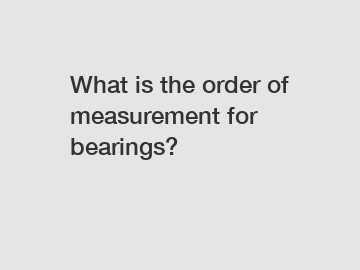What is the order of measurement for bearings?
What is the order of measurement for bearings?
Bearings are an essential component in machinery, enabling smooth and efficient rotation with minimal friction. Accurate measurements of bearings are crucial for identifying the appropriate fit and ensuring optimal performance. In this article, we will discuss the order of measurement for bearings, examining the various dimensions and parameters involved.
Types of Bearings.

Before diving into the measurement process, it is important to understand the different types of bearings commonly used. There are several types of bearings available, including deep groove ball bearings, angular contact ball bearings, cylindrical roller bearings, tapered roller bearings, and spherical roller bearings. Each type has its own distinctive design and function, catering to diverse industrial applications and load requirements.
Primary Measurement Parameters.
The measurement process for bearings involves several parameters that define their size and fit. The primary measurement parameters include:
1. Inner Diameter (ID): Also known as the bore diameter, it refers to the measurement of the inner ring's diameter. This parameter is crucial as it determines the fit of the bearing to the shaft.
2. Outer Diameter (OD): The outer diameter corresponds to the measurement of the outer ring. It is important to measure the OD accurately to ensure proper positioning within the housing or bearing structure.
3. Width or Height (W): The width or height measurement represents the distance between the outer and inner rings. This parameter is crucial for determining the overall size and fit of the bearing assembly.
Secondary Measurement Parameters.
In addition to the primary parameters, there are several secondary measurements that provide important insights into the bearing's characteristics. These secondary parameters include:
1. Clearance: Clearance refers to the internal gap or play between the rolling elements, inner ring, and outer ring. It is crucial to measure clearance accurately as it affects various factors such as load distribution, friction, and fatigue life.
2. Contact Angle: The contact angle is specific to angular contact ball bearings and represents the angle formed between the axis of the bearing and the contact point of the balls. It is essential to measure the contact angle precisely to ensure proper load distribution and optimal performance.
3. Axial Play: Axial play refers to the axial movement of the bearing assembly. It is crucial to measure the axial play accurately to prevent issues such as excessive axial movement or insufficient axial clearance.
Conclusion.
Accurate measurement of bearings is essential for selecting the right fit and ensuring optimal performance of machinery. By considering primary parameters such as inner diameter, outer diameter, and width, as well as secondary parameters like clearance, contact angle, and axial play, engineers can make informed decisions about bearing selection and installation. Proper measurement techniques also aid in identifying potential issues and preventing premature failure.
If you have any further questions about bearing measurement or require assistance with your bearing needs, please do not hesitate to contact us. Our team of experts is here to help you make the right choices for your specific applications.
Contact us today for all your bearing inquiries and solutions.
Contact us to discuss your requirements of Hub unit bearing MR519923 for Mitsubishi Outlander front wheel, Automotive thin section bearings, 23 ( K ) series self-aligning ball bearings. Our experienced sales team can help you identify the options that best suit your needs.

Comments
0